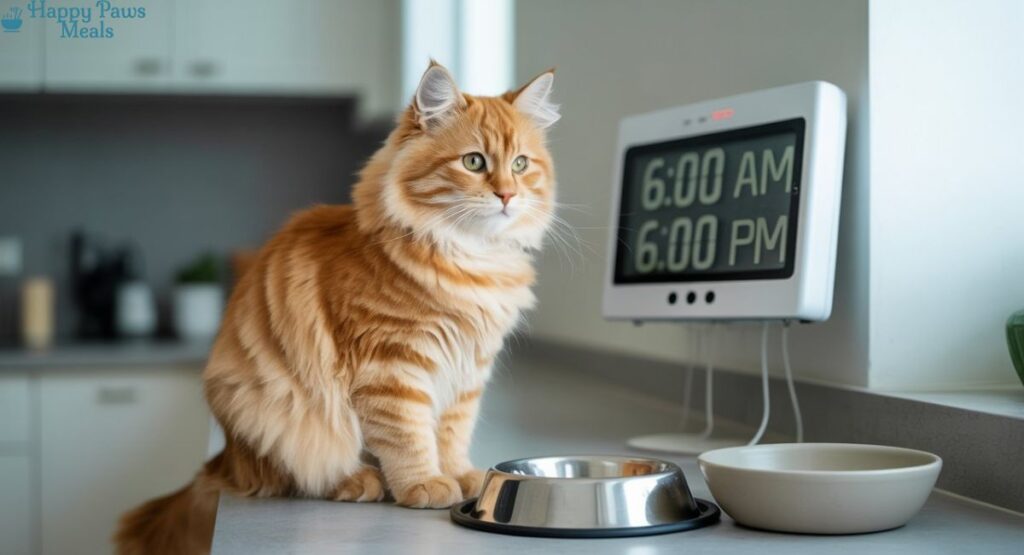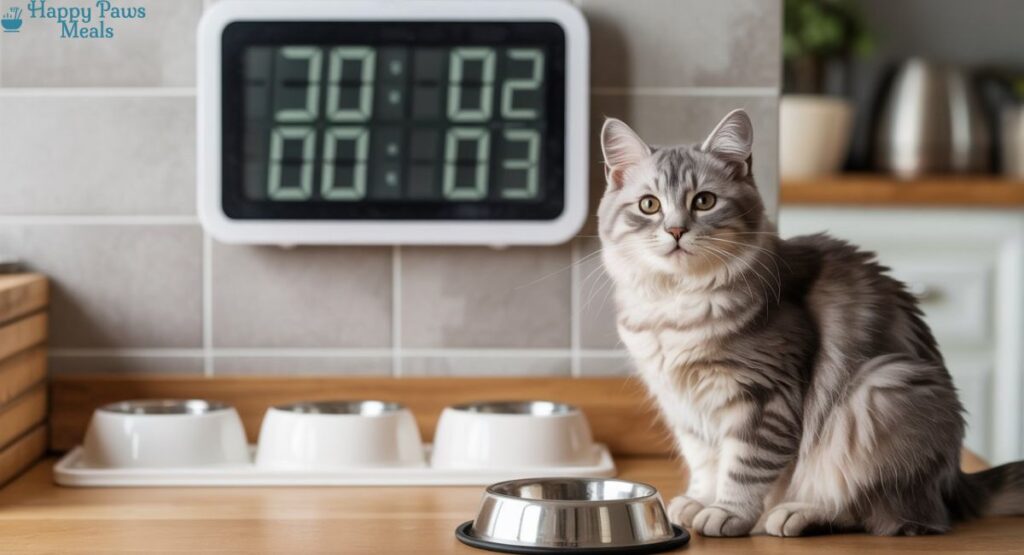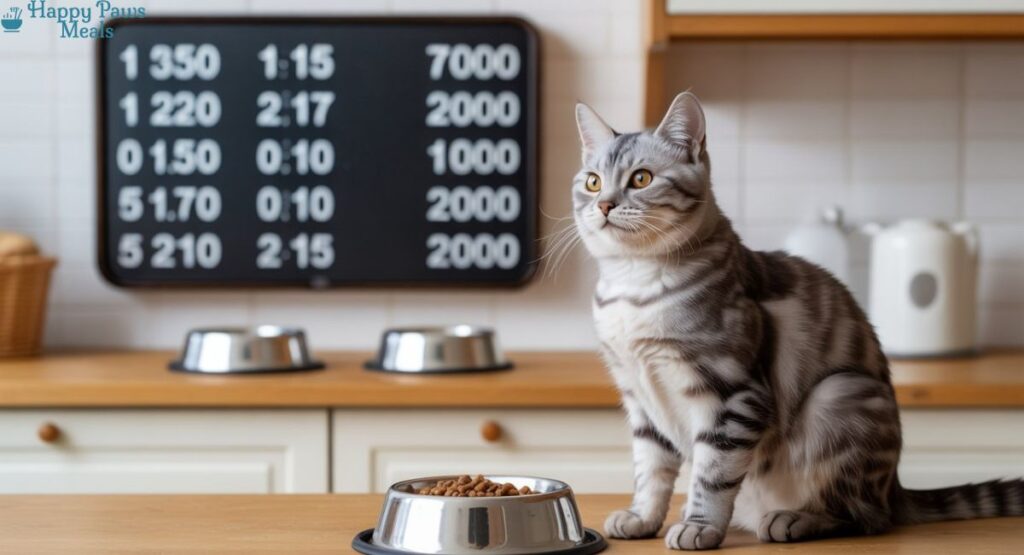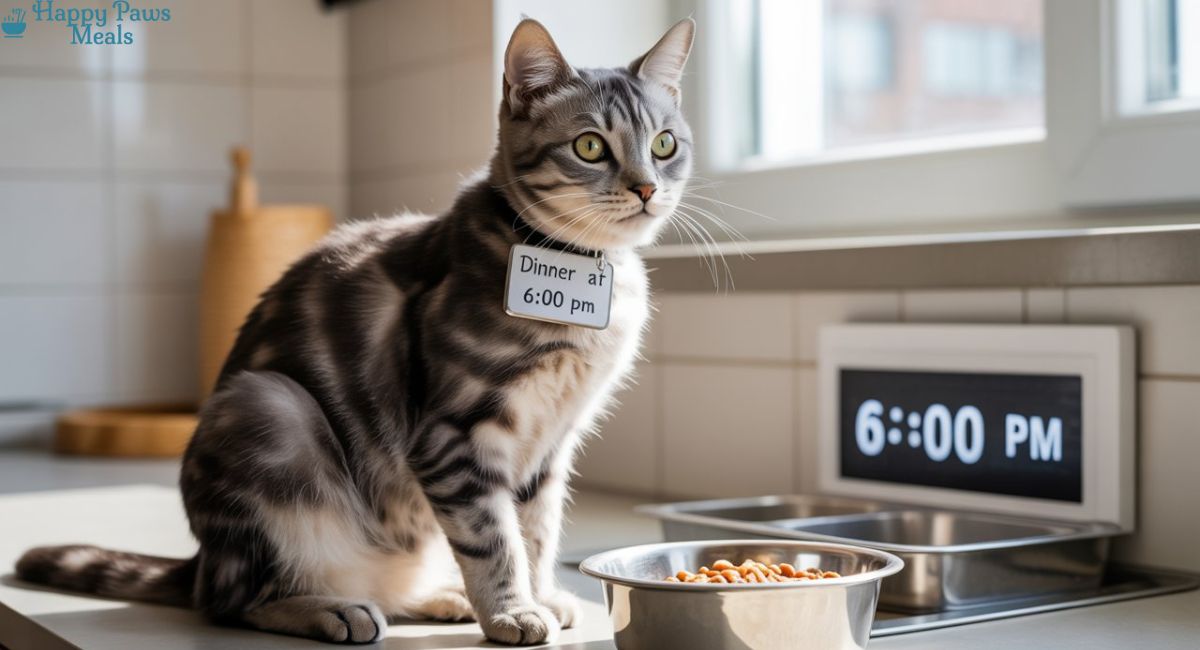Cats may seem independent when it comes to food, but their feeding schedule plays a huge role in overall health, weight management, and even behavior. Many cat parents struggle with questions like “How many times a day should I feed my cat?” or “Is it better to free-feed or set fixed times?” Establishing proper feeding hours for cats ensures they maintain a healthy routine.
In this complete guide, we’ll break down everything you need to know about feeding hours for cats — from natural eating patterns to vet-approved schedules, age-based routines, and practical tips for busy cat parents. By the end, you’ll have a clear plan that keeps your cat healthy, happy, and thriving.
🐾 Why Feeding Hours Matter for Cats
Cats are creatures of habit. Their stomachs, metabolism, and behavior all benefit from predictable feeding times. Many vets agree that consistent feeding hours for cats help improve digestion and weight control. Here’s why feeding hours matter:
- Prevents Obesity – Overfeeding or random feeding often leads to weight gain.
- Supports Digestion – Cats digest food better when meals are spaced properly.
- Reduces Stress – Routine feeding lowers food-related anxiety.
- Encourages Play – Cats are natural hunters; feeding after play mimics hunting cycles.
- Strengthens Bond – Scheduled feeding times create trust between you and your cat.

🐈 How Cats Naturally Eat in the Wild
In the wild, cats are solitary hunters. They catch small prey (like mice or birds) multiple times a day. Pet parents often struggle with choosing the right feeding hours for cats depending on lifestyle. Instead of eating large meals, they consume:
- 8–12 small meals per day
- High-protein, moisture-rich food
- Frequent bursts of hunting, resting, and eating
This natural instinct explains why many house cats prefer grazing or multiple small meals. But since we can’t release them to hunt mice daily, pet parents must replicate this pattern with structured feeding hours. The ideal feeding hours for cats usually fall in the morning and evening, mimicking natural hunting times.
🍽️ Common Feeding Schedules for Indoor Cats
When planning feeding hours for cats, you have four main options:
1. Free Feeding (Food Always Available)
- How it works: Dry food left out all day.
- Best for: Cats that self-regulate (rare).
- Drawbacks: High risk of overeating, obesity, and food going stale.
2. Two Meals a Day (Classic Routine)
- How it works: Breakfast and dinner, 10–12 hours apart.
- Best for: Adult cats with stable weight.
- Drawbacks: Some cats get hungry in between.
3. Three Meals a Day
- How it works: Morning, afternoon, and evening feedings.
- Best for: Cats prone to begging or digestive issues.
- Drawbacks: Requires owner availability.
4. Four+ Small Meals a Day
- How it works: Small portions every 4–6 hours.
- Best for: Kittens, underweight cats, or cats with medical conditions.
- Drawbacks: Harder for busy pet parents unless using an automatic feeder.
👉 Pro Tip: If you can’t be home all day, invest in an automatic feeder to maintain consistent feeding hours.
🍼 Feeding Hours by Age Group
Kittens (0–6 Months)
- Frequency: 4–6 small meals per day
- Reason: High metabolism, rapid growth
- Best Feeding Hours: Every 4–6 hours
Juveniles (6–12 Months)
- Frequency: 3–4 meals per day
- Best Feeding Hours: Morning, midday, evening, and bedtime snack
Adults (1–7 Years)
- Frequency: 2–3 meals per day
- Best Feeding Hours: Breakfast, dinner (optional midday snack)
Seniors (7+ Years)
- Frequency: 2–3 small meals
- Best Feeding Hours: Same as adults but smaller portions to aid digestion
🥫 Wet Food vs Dry Food Feeding Hours
- Wet Food: Spoils quickly, should be fed at set meal times (2–4 times daily).
- Dry Food: Can be free-fed, but portion control is essential.
- Mixed Feeding: Many cat parents use wet food for main meals and leave small amounts of dry food in between.
👉 According to AAFCO nutrient guidelines, both wet and dry food can meet nutritional needs — what matters most is portion control and consistent feeding hours. Kittens require more frequent feeding hours for cats compared to adult or senior cats.

🩺 Vet-Recommended Feeding Hours
Veterinarians generally recommend:
- Two to three meals daily for healthy adults.
- Four+ meals daily for kittens.
- Tailored schedules for cats with health conditions.
Feeding should ideally align with your cat’s activity cycle:
- Morning (after waking) → Play, then feed
- Evening (before bedtime) → Play, then feed
This mimics the natural hunt-play-eat-sleep rhythm.
⚖️ Feeding Hours for Weight Management
Obesity is one of the most common cat health problems. Fixed feeding hours for cats also reduce overeating and food begging behaviors. To manage weight:
- Stick to two fixed feeding times daily
- Avoid free-feeding dry food
- Use measured portions (see Top Online Cat Food Calculators)
- Add interactive play before meals to burn calories
💊 Feeding Hours for Cats with Health Conditions
- Diabetic Cats: Require strict feeding schedules coordinated with insulin shots (consult vet).
- Kidney Disease: Smaller, more frequent meals with wet food for hydration.
- Digestive Issues: Multiple small meals reduce vomiting and improve digestion.
👉 Always consult your vet before setting feeding hours for a cat with medical conditions.
📅 Sample Feeding Schedule (24-Hour Example)
Indoor cats especially benefit from structured feeding hours for cats because they burn fewer calories.
Here’s a vet-approved feeding routine for an adult cat:
| Time | Feeding Recommendation | Notes |
|---|---|---|
| 7:30 AM | Breakfast (wet/dry combo) | After morning play session |
| 1:00 PM | Small snack (dry/wet) | Optional for working parents |
| 6:30 PM | Dinner (main meal) | After evening play session |
| 10:00 PM | Small snack before bed | Helps reduce night begging |
⏰ Tips for Busy Cat Parents
- Use Automatic Feeders – Keeps feeding hours consistent.
- Batch Prepare Wet Food – Store in fridge, serve on schedule.
- Stick to Routine – Cats thrive on predictability.
- Monitor Weight – Adjust hours and portions as needed.

🛠️ Tools to Maintain Feeding Hours
- PetMD’s Cat Feeding Guide – Portion and timing advice.
- Automatic feeders with timers.
- Cat food calculators (see our Top Online Cat Food Calculators).
❓ FAQs About Feeding Hours for Cats
1. How many hours apart should I feed my cat?
Most adult cats do best with meals every 8–12 hours.
2. Is it okay to free-feed my cat?
Only if your cat doesn’t overeat — otherwise, fixed feeding hours are better.
3. What’s the best feeding schedule for kittens?
Every 4–6 hours, with 4–6 small meals daily.
4. Should I feed my cat at night?
A small bedtime snack can reduce night begging, but avoid large meals.
5. Can I feed wet food once a day?
Better to split it into 2–3 smaller meals to avoid hunger spikes.
6. Do feeding hours change with age?
Yes — kittens need frequent meals, while adults and seniors need fewer but consistent meals.
7. Do vets recommend strict feeding hours?
Yes, structured feeding improves weight management and prevents health issues. Veterinarians recommend adjusting feeding hours for cats if you switch from dry to wet food diets.
📌 Related Articles (Internal Links)
- Chewy Cat Food: Best Picks for Healthy & Happy Cats in 2026
- Frozen Raw Cat Food: A Complete Guide for Cat Parents in 2026
- Top Online Cat Food Calculators
🐾 Final Thoughts
Feeding hours for cats are more than just routine — they’re essential for health, behavior, and well-being. Whether you choose two big meals, three moderate meals, or multiple small snacks, the key is consistency.
By aligning feeding hours with your cat’s natural instincts and nutritional needs, you’ll prevent obesity, improve digestion, and build a stronger bond with your feline friend.
If you’re unsure where to start, consult your vet and try out a schedule that works for both you and your cat. In the end, the right feeding hours will give your kitty a happier, healthier life.

I’m Awais Manzoor, the writer behind HappyPawsMeals. With years of interest in pet care and nutrition, I research and review cat and dog food to provide reliable, easy-to-understand advice for pet parents.


1 thought on “Feeding Hours for Cats: 7 Best Schedules for Healthy & Happy Kitties in 2026”